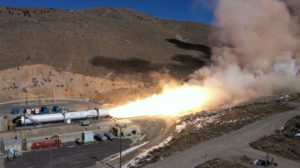PROMONTORY, Utah —Northrop Grumman [NOC] on Thursday conducted a successful first test of the second stage motor for its OmegA launch vehicle, a critical step as the company prepares for the first certification flight in spring 2021.
The OmegA rocket is Northrop Grumman’s offering for the Air Force’s competition to serve as one of two national security space launch providers, with contract awards slated for this summer and set to cover launches through 2026.

“The test was really good. The nozzle vectoring was spot on. So far, with very preliminary data, things are looking like we were wanting them to look,” Charlie Precourt, the company’s vice president of propulsion systems, told reporters here following the test.
The static test on Thursday of the C300 second stage motor, conducted at the company’s facility here, lasted for 139 seconds.
The Air Force in October 2018 selected Northrop Grumman, along with Blue Origin and Boeing [BA] and Lockheed Martin’s [LMT] United Launch Alliance for the Launch Services Agreement program to develop rocket technologies, as the service looks to end reliance on the Russian-made RD-180 engine by leveraging U.S. commercial launch capabilities.
Those three vendors, in addition to SpaceX, are vying for the Launch Services Procurement (LSP) contract vehicle, which will cover launch orders placed between 2020 and 2024. The first official launch under LSP is slated for 2022.
“When this program began, our first objective was to show the Air Force the pathway to replace the RD-180, and then to build a launch vehicle around that. The major accomplishment of showing the nation has something that can replace the RD-180 capability is demonstrated now,” Precourt said.
Last May, Northrop Grumman completed a largely successful static test of OmegA’s C600 first stage motor, while they noted an irregular issue to do with the aft exit cone that occurred at the end of the firing where parts of the cone appeared to explode away from the launch vehicle (Defense Daily, May 30).
Northrop Grumman’s Launch Services Agreement with the Air Force included $792 million to develop and verify OmegA as well as covering two certification flights, the first in spring 2021 and a second flight a few months later.
Saturn Satellite Networks will serve as the first customer for OmegA, which will launch two satellites as part of the first certification flight next year, the company said in December.
Burke Williams, program manager for OmegA’s common boost segments, said remaining work ahead of the first certification flight includes insulating rocket motor domes, building the final nozzles and igniters, and completing cases for the C300 and C600’s common boost segments.
“For certification flight one and two, we’re well down that road. And we’ve got a customer for the first one, so we’re going to fly them,” Williams told reporters when asked if Northrop Grumman expects the certification flights to continue in the event the company isn’t selected for LSP.
Williams said his team has focused on reducing the manufacturing time for a complete OmegA rocket below the Air Force’s two-year requirement, with a goal to get down to 12 months to deliver the launch vehicle after an order is placed.
“The requirement for the Air Force is two years. We have to be able to say ‘go’ and have something ready in two years. But we’ll be well under that,” Williams said.